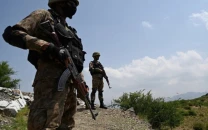As gloomy year ends, 2022 shows ‘economic uplift’
IMF expected to release $1 billion in loan to Pakistan in January and February

The country’s economy unexpectedly entered into a relatively higher growth mode despite underperforming during the calendar year 2021.
The incentives-laden original budget presented in June 2021 for the current fiscal year set the stage for a further expansion in businesses and economy.
The stimulus package, the then low benchmark interest rate at 7%, slightly overvalued rupee and central bank measures to inject ample liquidity into the system through different schemes accelerated business and economic activities beyond expectations during the second half of the year 2021 -- July-December.
Accordingly, the economy became overheated with inflation reaching a 21-month high double digit at 11.5% in November 2021.
The import bill hit a record high of $8 billion in the month, trade deficit widened to a record high at over $5 billion and the current account deficit soared to a 40-month high at $1.9 billion in the month.
Also read: Reviewing economy in 2021
The expansion in the economy beyond authorities’ expectations during Jul-Dec 2021 (which is first half of current fiscal year 2022 as well) and significant rise in global commodity prices like petroleum products and LNG – which was a major cause of the surge in monthly import bill and current account deficit – started reducing foreign exchange reserves and caused notable depreciation of 17% (or around Rs26) in domestic currency to record low of Rs178.24 against the US dollar by December 29, 2021 compared with 22-month high of Rs152.27 in May 2021 in the inter-bank market.
The developments prompted the central bank to aggressively increase the benchmark interest rate by a cumulative 2.75 percentage points during Sep-Dec 2021 to 9.75% at present.
The targeted measure of the rate hike was aimed at controlling inflation, narrowing down the current account deficit and improving the balance of international payments.
At the same time, it helped limiting economic growth to pre-planned level of around 5% in the current fiscal year 2022 against the existing potential for higher economic growth.
"The growth of over 5.25-5.5% would damage the economy if taken in current fiscal year 2022," Finance Minister Shaukat Tarin had recently said.
Earlier, the country unexpectedly saw a jump in economic growth to 4% in the previous fiscal year 2021 against the contraction of 0.5% in the prior fiscal year 2020 amid Covid-19 pandemic.
The year 2021 also saw the International Monetary Fund (IMF) $6 billion loan programme resuming in February 2021 after remaining on hold for the past one-year amid the pandemic.
The programme was again halted in June 2021 on difference between the government and IMF teams on the way to deal with the financial crisis in Pakistan.
Also read: December blues
Recently, the two sides reached a staff-level agreement in late November 2021 to resume the programme.
The IMF Board would be presented with the sixth review of the economy under the loan programme on January 12, 2022.
Accordingly, the IMF would release the next tranche of $1 billion of the loan to Pakistan in January-February 2022.
This will be followed by raising foreign debt by selling Sukuk (Islamic bond) by the government in international market, other inflows from multilateral and bilateral lender and rollover of maturing foreign debt during the year 2022.
Such inflows are estimated to build up foreign exchange reserves by net $1.3 billion to $27.5 billion by end of June 2022 and help the rupee to partially recover ground against the US dollar in the inter-bank market during the year.
Now the nation has entered 2022 with the benchmark interest rate reaching close to its peak expected at 10% in March 2022.
The rupee partially recovered almost 1% (or Rs1.73) against the US dollar in the last two working days of December 2021 to Rs176.51 after losing to a record low of Rs178.24 on December 29, 2021.
Also read: Slumpflation and structural constraints
The expected cut in the benchmark interest rate to 9.25% during second half of calendar year 2022 and stabilisation in the rupee-dollar parity at around Rs178 against the US dollar till end of June 2022 would reset the economy back to high growth mode from second quarter (April-June) of 2022 and onwards.
"The inflation reading is expected to slow down into single digit and current account deficit coming back into affordable range of $600-800 per month from February-March 2022 and onwards," said Pak-Kuwait Investment Company Head of Research Samiullah Tariq.
However, Fahad Rauf, the head of research at Ismail Iqbal Securities, said the second half of 2022 might see increased political noise.
“This will be because political parties would start preparations for the next parliamentary poll expected in fourth quarter (October-December) of 2023," he added.
The preparations may prod the ruling PTI party to spend more on development projects and the masses to keep intact its vote bank.
The expected higher spending, however, might increase the deficit in fiscal year 2023, as the completion of IMF loan programme of $6 billion in September 2022 (as per the original programme) would allow the government to increase spending beyond available resources.
The calendar year 2022 may see improvement in inflation, some appreciation in the rupee against the dollar and cut in current account deficit.
“However, "they (inflation, rupee-dollar parity and deficit) would remain elevated during 2022," Rauf added.
The next fiscal year 2023 is expected to record an economic growth of 5.4% compared to 5.2% estimated for ongoing fiscal year 2022, said Arif Habib Limited Head of Research Tahir Abbas.



















COMMENTS
Comments are moderated and generally will be posted if they are on-topic and not abusive.
For more information, please see our Comments FAQ